Everything Is Broken
The ground beneath your feet is pitted and wrecked, the mighty towers in which you took so much pride rain death down on the heads of those passing below, and yet another massive storm wends its way toward your desolate environs. Look upon the ruin that you call your city and despair, New York. This is what happens when you let the Democrats back into Gracie Mansion.
Bill Russell Is 80

William Felton Russell, the first African American coach in American professional sports and indisputably one of basketball’s greatest all-time players, an “impassioned advocate of human rights” and “a consistent advocate of equality,” as the White House put it when awarding him the Presidential Medal of Freedom in 2010, turns 80 today.
The "Light Thinking Followed By Typing" Industry Strikes Again

Flappy Bird Think Pieces Dot Tumblr Dot Com has helpfully aggregated segregated all the long pieces of writing about the short-lived app sensation Flappy Bird, so that they will not appear anywhere else on the Internet and you won’t be disturbed by them. LOOK ONLY IF YOU DARE. An emotional winter is coming. No but seriously, the trick is picking the good one!
The Right Way To Rank Boys
by Matthew J.X. Malady
People drop things on the Internet and run all the time. So we have to ask. In this edition, writer and @TIMENewsfeed editor Jessica Roy tells us more about an approach to assessing boys that she used in the eighth grade.
fyi boys according to my 8th grade diary “plays hard 2 get” is a PRO pic.twitter.com/voOEJiOs13
— Jessica Roy (@JessicaKRoy) February 4, 2014
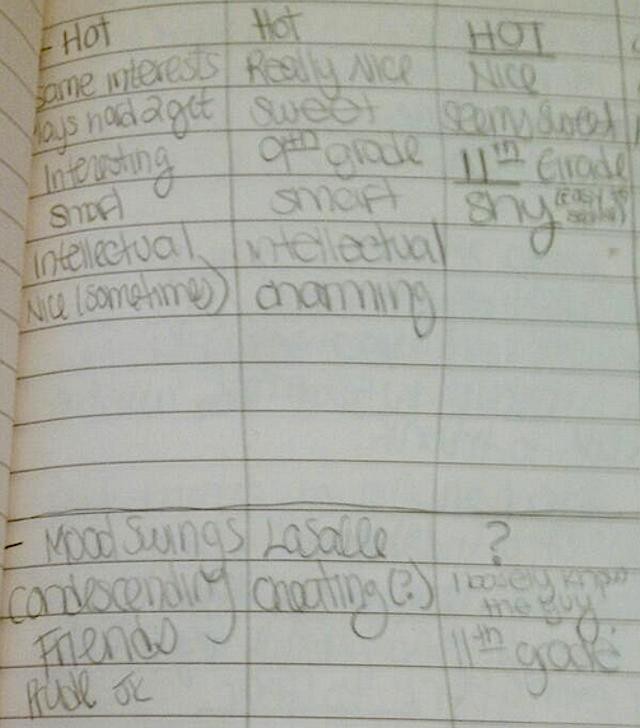
Jessica! So what happened here?
I’ve kept a diary since I was eight years old; I’ve also been embarrassing myself in writing since I was eight years old. This photo is of a page from the diary I kept in eighth grade, when I was 14 and boy crazy and just learning how much power having boobs gave me without really knowing how to wield that power gracefully or responsibly. The complicated-looking matrix pictured is a pros and cons list of the three boys who had crushes on me (I have never been, nor will I ever be, as in-demand as I was at 14). Each column represents a boy — the first one a ninth grader, the second one a guy from a private school in my town, and the third one a vaguely creepy 17-year-old who was always hitting on me via AIM. The top half outlines the pros and the bottom one the cons.
I remember feeling really mixed up and borderline cry-y when I sat down to write this — not sure who to like, or who really liked me, or if I even knew what liking a boy meant. I was really into this trashy YA series called “The Clique” at the time, and the sassy teen narrator was obsessed with making lists, and this appealed to my OCD tendencies. So when it came to boys, I approached it the way any overwhelmed writerly tween would: by creating a dorky pros and cons diagram in my diary, as if I was making a grocery list and couldn’t decide exactly what I should make for dinner. Pros include: “Plays hard 2 get” and “Shy (easy to seduce).” Cons are “Cheating (?),” like I wasn’t sure if he was a player or not (he was), and “Prude JK.” These are still cons IMO.
What are your favorite entries, and how would the traits you focused on back then compare to the traits you would be looking to chronicle if you were to make a modern-day version of this thing?
I think my favorite is “Shy (easy to seduce)” because I was 14 and had barely even kissed a boy, so obviously I had no clue how to “seduce” anyone, unless “seducing” him included luring him into my parents’ basement with my sick clarinet skills, or bringing him to Limited Too so I could get a cheap suburban thrill from shoving low-slung flare jeans into my bag while he distracted the sales clerk. (Note: I still do not know how to seduce anyone.)
Some of the other entries still ring true, though: being smart, sweet, and charming are all important traits for a Mr. Jessica to have, and being super moody or having condescending friends are fair cons. If I were making a new pros and cons matrix for 25-year-old Jessica, an additional pro would be “good sexter” and a con would be “calls cats ‘it.’”
Lesson learned (if any)?
Never unearth your middle school diaries unless you are equipped to deal with the fact that they will sound alarmingly like Thought Catalog posts. Also: My parents really should’ve locked me in my room until I turned 18.
Just one more thing.
I eventually did end up making out with the guy from column three on the sofa in my parents’ living room, and it was TERRIBLE. Remind me to add “bad kisser” to his list of cons.
Matthew J.X. Malady is a writer and editor in New York.
New York City, February 10, 2014

[No stars] The snow from overnight, now the newest old snow, lightly covered the older and dirtier snow. On cars that had been driven, melted patches showed the ghostly pattern of the internal structure of their hoods. To the east, the sun on the whiteness and the wetness gave everything a spurious pristine shine. The cold was bleak, neither shocking nor capable of being ignored. Breath steamed on the subway platform at noon. A man walked by with his hands thrust in the high pockets of his pea coat, the posture even more pinched and uncomfortable-looking than hands-in-pea-coat usually is. The ground presented every sort of leftover slipping hazard: watery slush, packed glazed snow, refrozen invisible black ice, thick slippery ice-slabs — all demanding the most tedious sort of careful attention. An immense chunk of asphalt had been blasted out of a pothole on Broadway, leaving behind two sibling chunks rattling loose in the crater. A sliver of distant sky at sundown was in lovely shades of violet, if you took an eye off the dangerous footing. At night, bleached light bounced off the sparsely populated sidewalks of Times Square. People were still sitting on sidewalk stools to have their caricatures drawn.
If You Like Sports And Charts You Will Love These Charts About Sports
There is an old joke that goes something like this:
A guy calls his bookie and says, “Okay, how’d I do on the baseball game?”
“Terrible,” says the bookie. “You lost ten grand.”
“Ten grand? Shit. Well, I must have broken even on football.”
“No way,” says the bookie. “There was an interception that totally screwed you on the spread.”
“SHIT SHIT SHIT” screams the guy. “What about the basketball game?”
“Don’t even ask,” says the bookie.
The guy starts weeping. “Where am I gonna find thirty frigging grand? What am I gonna tell my wife? What the hell am I gonna do?”
“Well,” says the bookie, “you can always try to even it out by rolling it over on the hockey match.”
“Hockey?” the guy screams into the phone. “What the fuck do I know about HOCKEY?”
That’s it, that’s the bit. It’s funny because the guy clearly knows nothing any of the sports — which are, in the magical way things only happen in jokes, somehow all in season at the same time — but he believes that it is only hockey about which he is ignorant. It is a metaphor for our own cognitive biases. But it speaks to a larger point: Who the hell does know anything about hockey? It turns out, rich people. I’m as surprised as you are.
Buy All Of Exene Cervenka's Stuff!

The amazing Exene Cervenka is selling all her crap? YES, starting Thursday, in Santa Ana, California, a four-day estate sale will begin at which you can grab the legend’s vintage dolls, Victorian childrens’ clothing, Old Carnival Chalk Prizes and “much much more.” (I sense a theme.) But not the guitars!
yes i’m having a cool sale… but the guitars pictured in the onion are not from my sale!!! i don’t know where that pic came from!!
— Exene Cervenka (@exenecervenka) February 11, 2014
She is downsizing, something we should probably all be doing. Unless we’re homeless. (via)
Crocs Climb Trees

“Dinets and his colleagues observed crocodile species on three continents — Australia, Africa and North America — and examined previous studies and anecdotal observations. They found that four species climbed trees — usually above water — but how far they ventured upward and outward varied by their sizes. The smaller crocodiles were able to climb higher and further than the larger ones. Some species were observed climbing as far as four meters high in a tree and five meters down a branch.”
–Pictured: a crocodile that has climbed a tree.
Photo by Kristine Gingras
On "Dawson," on "Dexter," on "Damages": The Artists and Art of TV Shows
by Johannah King-Slutzky
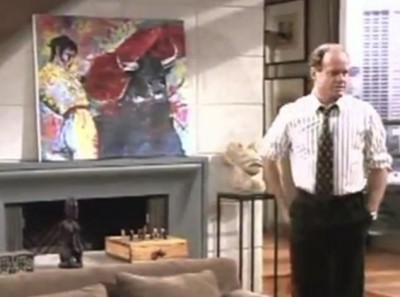
A couple months ago I was watching an episode of the second season of “Dawson’s Creek” when I saw an intriguing painting, “Winter’s Mist,” by an artist called “Jarvis.” “Winter’s Mist” looked vaguely familiar and the artist’s name was something I might’ve heard in college. Here is what the on-TV college lecturer had to say about it:
I’d like to close with this piece, “Winter Mist.” It’s Jarvis’ most famous work. No one can deny after looking at this exquisitely tuned surface, the juxtaposition of color and shape, the intensity of his lines, that Jarvis was in complete control of his new technique. Sadly, three weeks after Jarvis completed “Winter Mist,” he died from alcohol poisoning. Despite his untimely death, Jarvis left a lasting impression on the art world and his title of one of the abstract expressionists of the 20th century will live on.
The painting is a revelation for the show’s stars, Joey and Jack, who are high school auditors. For Joey, it’s her first exposure to serious art and launches her on an (eventually aborted) character arc in which she pursues her true passion, figure drawing. For Jack, it is the beginning of a creeping admission that he might be a little too cultured for heterosexuality. (This was 1998.)
Art as sexual revelation makes a second appearance later in the season when Joey draws a Titanically nude Jack, after which the pair a) almost get it on, thereby severing Joey’s relationship with Dawson, and b) confirming that Jack does not enjoy sex with women.
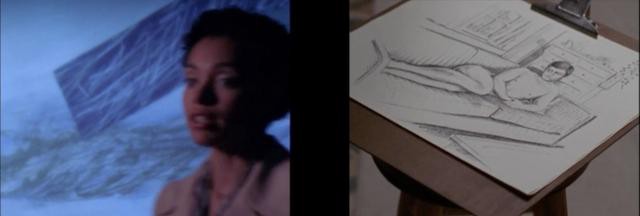
Screencaps from “Dawson’s Creek.” Left: “Winter’s Mist,” by Jarvis. Right: sketch of Jack McPhee, by Joey Potter.
It turns out there is an abstract expressionist named Jarvis — Donald Jarvis — but he died in 2001, three years after that “Dawson’s Creek” episode aired and proclaimed Jarvis long dead. Definitely not the same Jarvis. But I was intrigued that a piece of fake art had been given provenance, auteur mythology, and emotional resonance. What was at stake here?
Since I found “Winter’s Mist,” I’ve been keeping a log of all the fine art I see on television, which you can find at artontv.tumblr.com. My favorite is the really bad art you see on shows like “Law & Order: SVU,” “Revenge,” and my current art favorite, “Bones.” Almost as a rule, crime pays off in bad taste. I have also yet to encounter a TV program that does not feature at least one artist or work of art, much in the same way that sitcoms tend to oversample brick lofts.
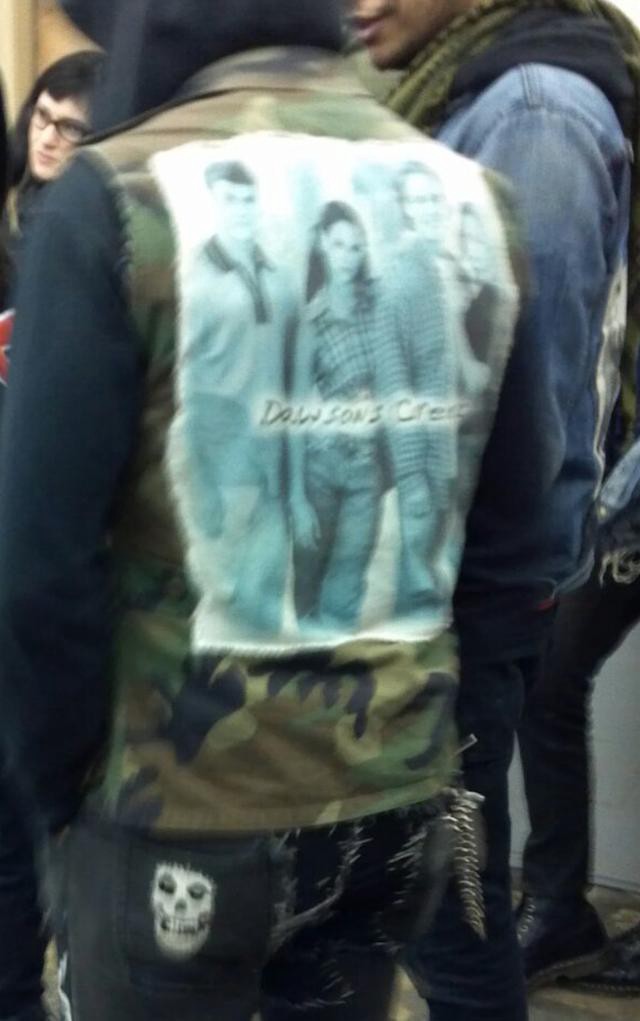
No narrative purpose. Much respect.
I spoke with the art historian David Raskin for some insight into some of TV’s mediocre and very bad art. Raskin, whose most recent book is on minimalist artist Donald Judd, specializes in modern and contemporary art history. According to his faculty profile at the School of the Art Institute of Chicago, he’s particularly interested in the question “What makes art credible?”
For Raskin, TV art is almost always too palatable. “Performance art is not about someone splashing paint on walls. It’s about belief and necessity, about an artist risking him- or herself in public,” he said. “There’s no risk here, just a mess to clean up.”
As an example, here is one of my bad art favorites: from “SVU,” an example of performance art that supposedly comes to us by way of the Saatchi Gallery.
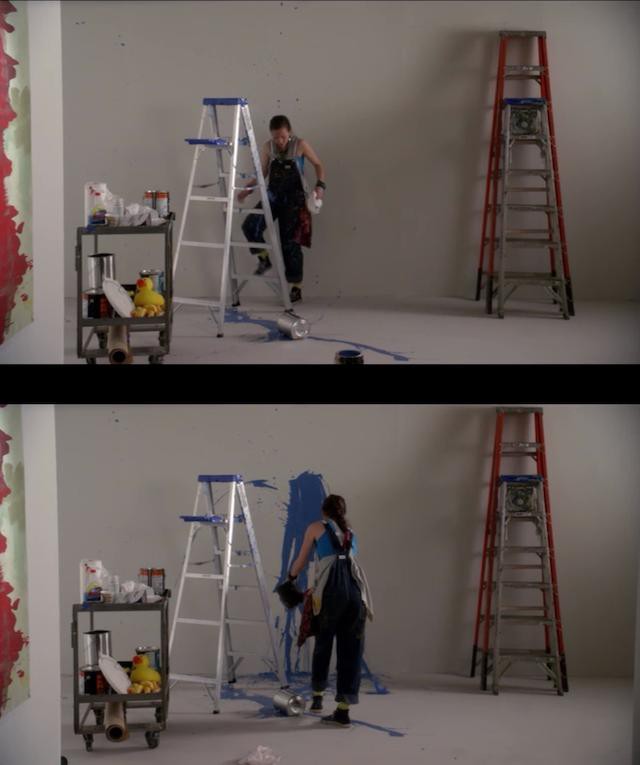
Stills from “Law & Order: SVU.” According to the gallery owner, “talent like hers is very rare.”
Then there’s TV art that you can’t distinguish from real art at all. For example, I had to take to social media to confirm that this painting, from “Damages,” was not secretly a Pollock or (in Raskin’s more likely comparison) a Frankenthaler.
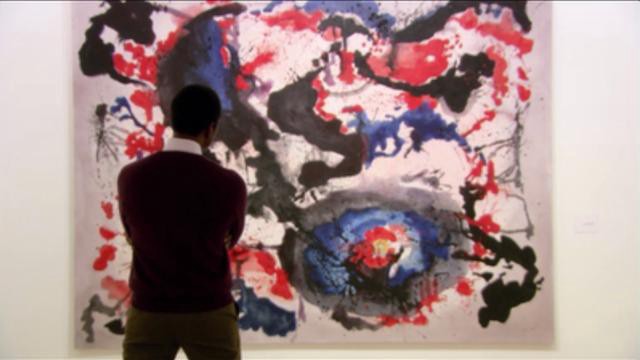
Screencap from “Damages.”
Most TV art straddles the ridiculous and the familiar. Because of this, TV art’s paratexts signal inauthenticity while the painting, sculpture, or performance themselves remain unremarkable. For example, on “Bones” the fictional artist Geoffrey Thorne crushes cars into tofu-like blocks, films the machinery, and stages the finished slabs as sculpture. It’s a stunt Raskin dismissively calls “big metal.” But the concept and process is not unreasonable — or unfamiliar. John Chamberlain began endlessly crushing cars in 1959, and, the same year this episode of “Bones” premiered, the German artist Dirk Skreber was crushing cars for art, too.
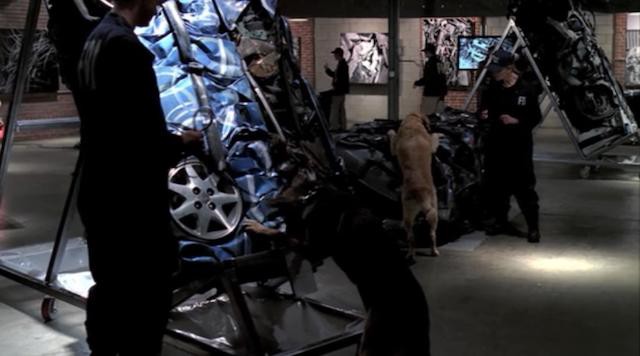
Screencap from “Bones.”
TV art is headed in the right direction, but it’s been flattened. The failure of these fabricated art objects to be neither valid nor completely ridiculous means that most of the comedy comes from outside the art. In the same “Bones” episode, the gallery owner is a dragon lady white woman in Geisha costume. She says things like, “Goeffrey’s work is a brilliant examination of consumerism and the destruction of the soul” while commanding the FBI not to stomp on her pig’s-blood-covered floor.
Good narrative must show, not tell, but without an organization like the Public Art Fund or HBO’s coffers, you can only finance so much. I suspect this, and not anti-art sentiment, is why TV’s artists and critics are such windbags: their task is to reveal what the art cannot. In this system, the badness of art and artist is tautological. TV shows buy generic prop art because they couldn’t possibly get the good stuff; then, the burden of exegesis falls onto the artist. But because his or her work is plainly boring, script writers have to make the artist into a self-important lunatic in order to caulk the cognitive dissonance. This only amplifies the boring art/windbag artist trope for future TV shows.
One way to escape this mythology is to make the art worse and less legitimate. That’s what happens on sitcoms like “Friends.” Other shows deflate artists through intelligent criticism. On “Damages,” Patty Hewes’s prodigal son is an artist who knows he’s borrowing legitimacy conferred by his gallerina girlfriend. “de Kooning supported himself as a house painter when he first came to America,” says his girlfriend, Jill. “I don’t think you’re looking at the next de Kooning,” he replies.
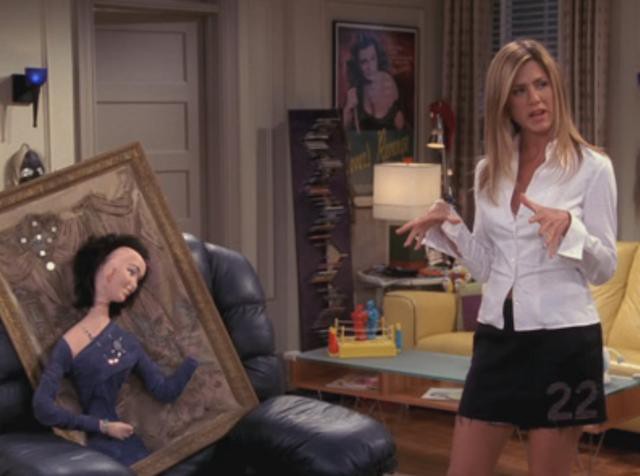
Screencap of extremely bad art from “Friends.”
Then again, sometimes we really do just need to poke fun at art. On “Six Feet Under,” which could afford to and did feature the work of real artists, Claire Fisher accurately explains the ideology of gigantism when confronted with a huge lollipop sculpture. Then another character points out that the artwork’s oversexed creator has built yet another shrine to his penis.
How does art actually get on TV? There’s the stuff that comes from prop shops, like “Winter’s Mist.” When you factor in decorative art, this is the vast majority of art on TV.
Then there’s real art by real artists which simply happens to be spotlighted on television. “The L Word” makes good use of art by featuring artists like Catherine Opie both in the diegesis and the credits.
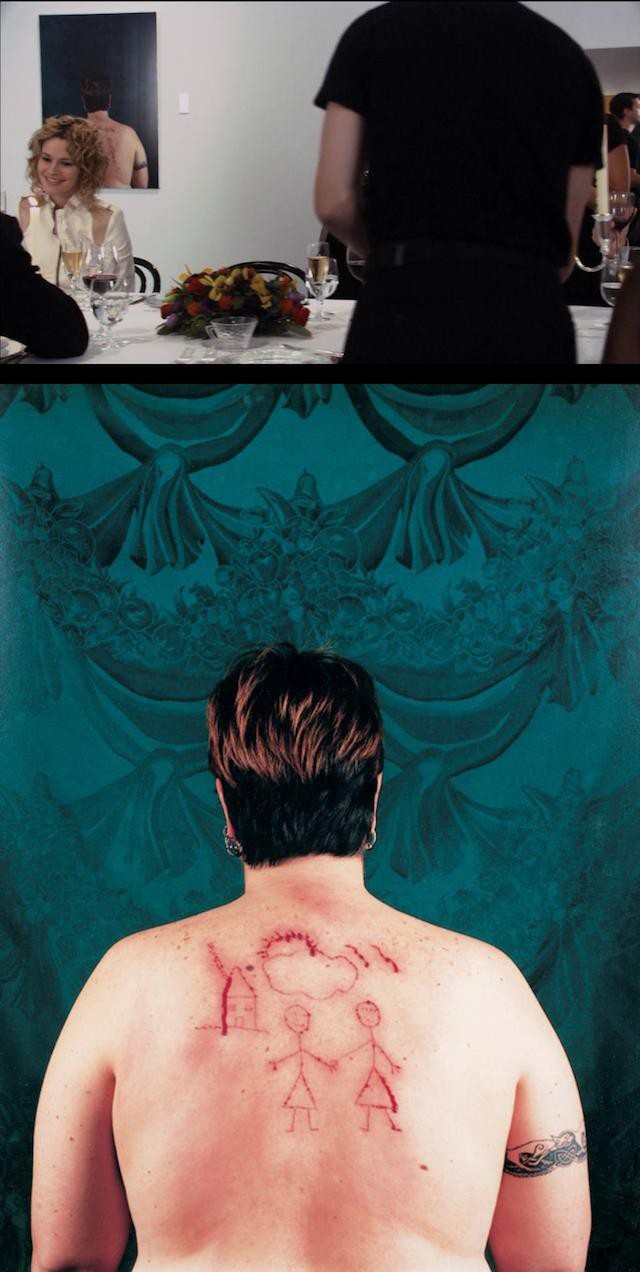
Top: Screencap from “The L Word.” Bottom: Catherine Opie’s “Self-Portrait/Cutting” (1993).
There’s also art which has been commissioned from real artists expressly for appearance on television. “Gossip Girl” does this with very impressive artists, thanks to the show’s alliance with the Art Production Fund. IRL artist Jessica Craig-Martin’s glossy close-ups of skirts and poolside legs are perfectly matched for “Gossip Girl.”
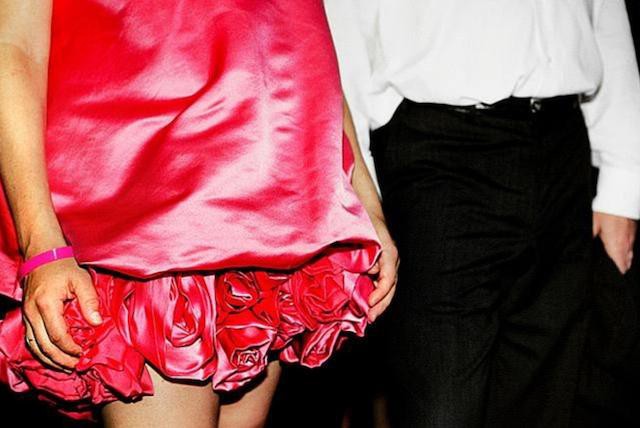
Jessica Craig-Martin’s “Showing Pink” was commissioned by “Gossip Girl” for appearance in the van der Woodsen home.
On “Six Feet Under,” Claire’s scary mask portraits of her family were done by David Meanix, who “hounded” the show’s art director for two years. And, late in the show, the disturbing wedding portraits “shot” by Claire were taken by Lara Porzak, whose clients include everyone from James Van Der Beek to Brad Pitt (with a stop-off at Ellen DeGeneres’s wedding).
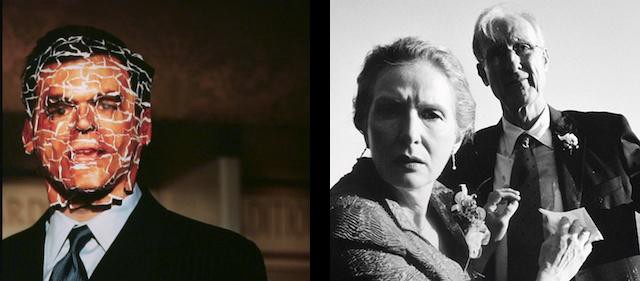
While TV shows like “Gossip Girl” and “The L Word” feature great art from real artists in almost every episode, shows like “Girls” exhibit art by their production teams.
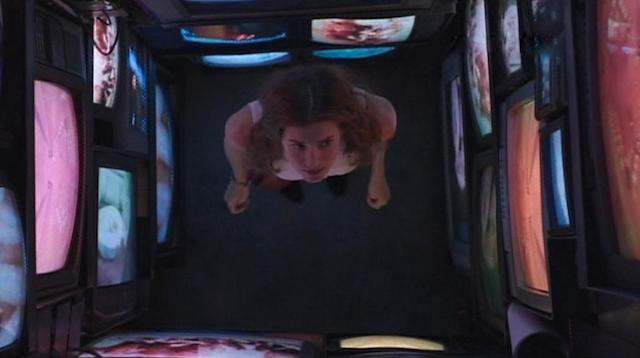
Booth Jonathan’s unnamed video box was made for “Girls” by production designer Matt Munn.
But for art that is not commissioned or not made in-house, the most opaque part of the process of getting art on TV is not where production crews get their art, but how art ends up in prop shops in the first place. For this, I emailed artist Lisa Gizara, a photographer and painter whose work has appeared on shows as diverse as “House,” “CSI: Las Vegas,” “Californication,” “Castle,” “Whitney,” “Modern Family,” and most notably, as Roger Sterling’s office decor on “Mad Men.” You will also be able to see her work in the upcoming Terrence Malick film Knight of Cups.

Left: Still from “Mad Men.” Right: Lisa Gizara’s “Queen of Hearts.” Both images courtesy of the artist.
According to Gizara, artists shouldn’t expect to be contacted by art directors or prop shops out of the blue:
Initially a friend introduced me to the art director for the pilot for “Californication.” He asked to see some of my work and requested that I put together a number of images of New York City. He chose a piece of mine that ended up on the set on the fireplace mantle in Hank Moody’s apartment. It was an infrared photograph of Washington Square Park in NYC and you can see it on the pilot.
After that I approached an art sales and rental gallery that caters to the film and television industry. There are several in Los Angeles. I mentioned that I had my work on “Californication” and the curator of the space asked that I email a small selection of my artwork and photos. Then the curator asked that I bring in a number of framed images for the showroom — that was in 2007. I have been working with them now for 7 years and continually see my work on commercials, TV shows and feature films.
Most of the art you see on TV has been rented. At Lost and Found, a Chelsea-NYC prop shop with a larger than average collection of art, you can rent, say, framed embroidery of a horse for $75 per week or “Vintage Gold Tangle Sculpture” for $65 per week. Neither is for sale. Even innocuous artwork can be very popular. When I called for a price quote on Tangle Sculpture, it had already been rented out.
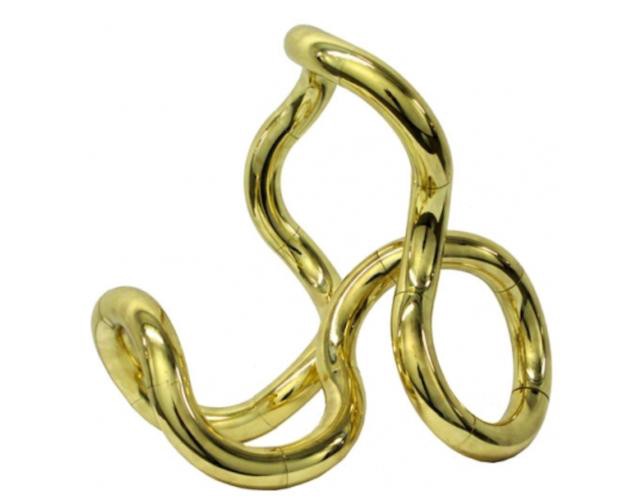
Vintage Gold Tangle Sculpture from Lost and Found.
Prop shops also have a separate category of art called “Cleared Art,” which is artwork whose rights are owned outright by the prop shop, meaning that there is no risk of copyright infringement for shows who wish to use recognizable or distinctive artwork. Cleared or otherwise, none of the paintings or sculptures I encountered at any prop shop publically displayed artist’s information. Artwork is identified primarily by a prop-shop assigned serial number, physical dimensions, and generic title (“Gold Tangle,” “Organic Painting”). Although Gizara always receives a paystub for her rented art, she’s not always informed which show actually intends to feature her painting or photo. “It takes some sleuthing on my part,” she said.
What can these props actually teach us about our conception of art? For one thing, we’re wary of abstract expressionism. If TV is to be believed, Ab Ex is pretentious, illegible — and the artist almost always has ulterior motives. If you plan to keep an eye out for art on TV, get familiar with this shot:
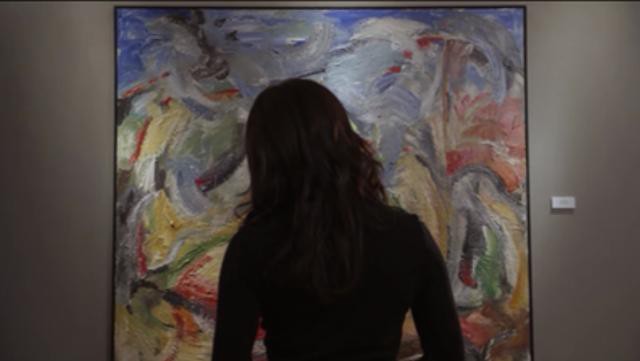
Screencap from “Parenthood”
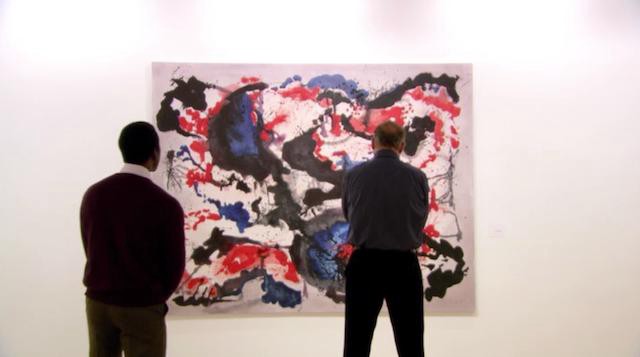
Screencap from “Damages”
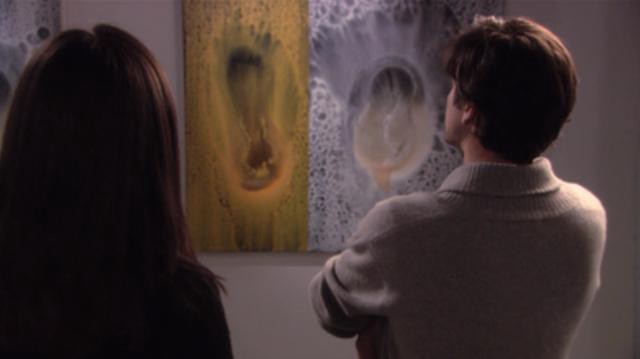
Screencap from “Gossip Girl”
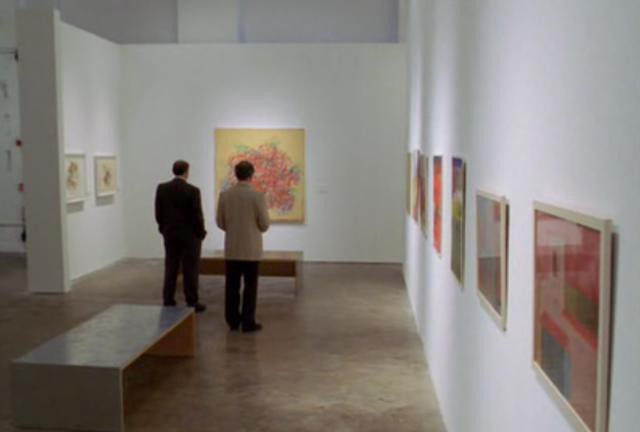
Screencap from “The Wire”
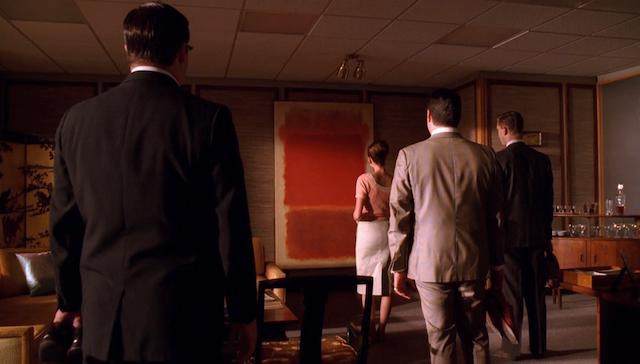
Screencap from “Mad Men”
Standard dialogue goes something along the lines of “Ruh??” For example, from “Damages”:
DAVE: I prefer paintings I understand. Foxes, hounds, bugles, that kind of thing. All this abstraction looks the same to me.
WALTER: Well, in this case, Dave, you’re right. This piece of shit is a waste of canvas.
Art might be more opaque, more pretentious, more cutting-edge, but it will not get this treatment unless it’s abstract.
Another preconception: only jerks make video art. I’ve seen a lot of murderers and adulterers look at Ab Ex, but video artists are just obnoxious. Performance, installation, and conceptual art also rank high on the jerk-o-meter. This expectation is entirely explicit. On “Gossip Girl,” the season two love interest/artist/skeezeball Aaron Rose is made into a video artist expressly because video and installation art require more viewer participation, which makes it “lazier.” From Aaron Rose’s ghost designer Nathan Nedorostek:
[H]is art was supposed to be very pretentious. With that we took the idea of this installation where he does video installation but there’s really nothing there, so what we wanted to do was have this idea that it was nothing he recorded, it was the viewers actually making his art for him.
You can tell a lot about what kind of show you’re watching from the way it treats art. Most TV shows distrust art, but every so often you’ll find a show that is really and truly optimistic: “Friday Night Lights” falls into this category, as does “Charmed” and sappy-happy “Dawson’s Creek.” Though the shows run the gamut of taste, all three programs confirm that art is complicated, but that’s okay. For example, imagine an exchange like this on a cynic’s show like “House”:
PRUE: So did the X-Ray confirm its authenticity?
JOE: It did a lot more than that. Check out the X-Ray. It’s got definitive underwriting on the canvas.
PRUE: It has a pentimento?!
JOE: Yeah, I couldn’t believe it either. But you can see it on the X-Ray. The text is in Latin! I’ve never seen anything like it before.
PRUE: [Reading painting] Absolvo Amitto Amplus Brevis. To free what is lost say these words.
JOE: Wow, you speak Latin?!
The pentimento turned out to be a spell attached to a haunted painted castle, natch. “Charmed”’s art-speak is laughable, but there’s nothing defensive here.
Compare that to a neurotic show like “Seinfeld,” whose most famous painting, “The Kramer,” is lauded only by the perversely indulgent.
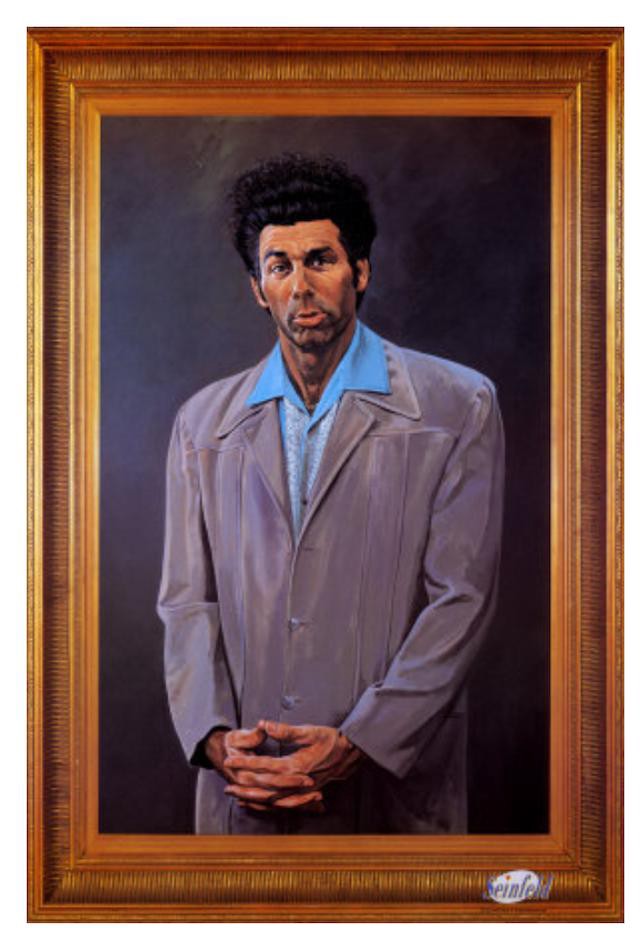
“The Kramer”
MRS. ARM: I sense great vulnerability. A man child crying out for love, an innocent orphan in the postmodern world.
MR. ARM: I see a parasite. A sexually-depraved miscreant who is seeking to gratify only his most basic and immediate urges.
…
MRS. ARM: Dirty and unattractive, and yet I detect a nobility of attitude, an unwavering loyalty, much like the St. Bernard.
MR. ARM: But look at the eyes. He’s a creature barely hanging onto existence, like a cockroach clinging to a sewer crate.
MRS. ARM: He is man struggling. He lifts my spirit.
MR. ARM: He is a loathsome, offensive brute, yet I can’t look away!
MRS. ARM: He bends time and space.
MR. ARM: He sickens me.
MRS. ARM: I love it.
MR. ARM: Me too.
Besides “Seinfeld,” “Bones,” “SVU,” and “Vampire Diaries” all go in for “postmodernism” lolz. None of this is surprising. Postmodernism is pretentious? Artists are horny? Whaaaa?
But there are moments in which TV reveals itself to be a more adept cultural lens. When I first started this project I expected to find a lot of classic portraiture, abstract expressionism, photography, and still life. And I have. But I’ve also found installations, performance art, and mixed media made of strange materials. “Dexter”’s incendiary Lila West was not a scrupulous portrait of creativity, but her presence still acknowledged that fine art might be made of mannequins as much as oil paint.
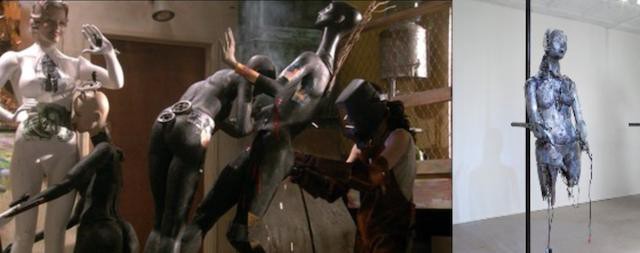
Left: Screencap from “Dexter.” Right: IRL art featured at the Whitney. Specifically, it is “Don’t Touch Me (Oil Spill),” by Stewart Uoo (2012), represented by 47 Canal St.
Several shows acknowledge the existence of (gasp!) kitschy commercial art, which I found on “Breaking Bad,” “Daria,” “Bob’s Burgers,” and, if we’re counting TBS-aired movies, Good Will Hunting. Although pop culture is invested in the tortured artist trope (one artist on “Bones” even wanted to die inside his sculpture), occasionally, prude commerce pokes through.
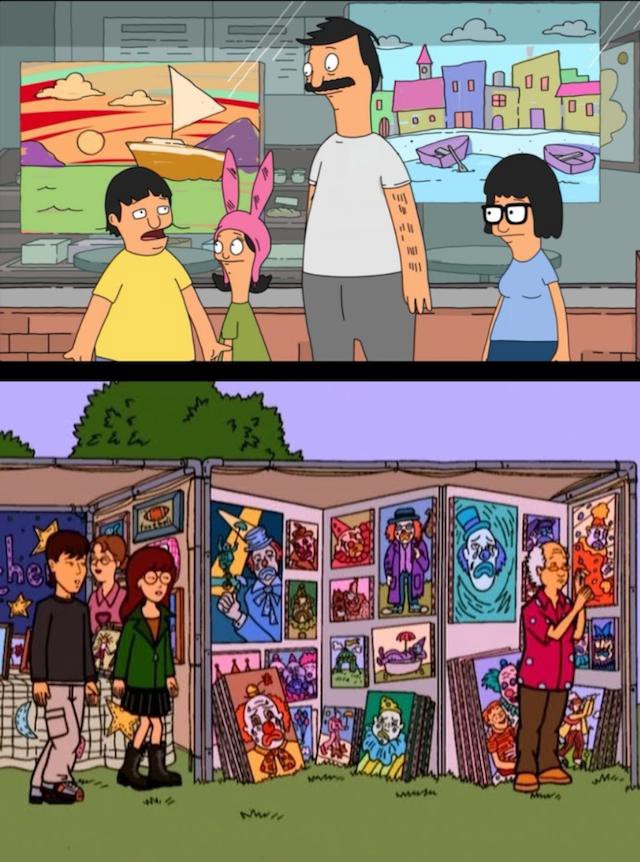
Cartoons do commercial art. Top: screencap from “Bob’s Burgers.” Bottom: Screencap from “Daria.”
Ab Ex still pisses us off, artists are tortured, PoMo is meaningless, the art world is for criminals and love bandits, everyone wants to get laid, and the shows you actually have to pay for have more realistic art. Bad or good, TV is an art education worthy of Hudson University.
Johannah King-Slutzky is awaiting her billion dollar grant to look at all this Law & Order art. Find her blog here or follow her @jjjjjjjjohannah. Found some good TV-art? Submissions welcome: artontv.tumblr.com.
